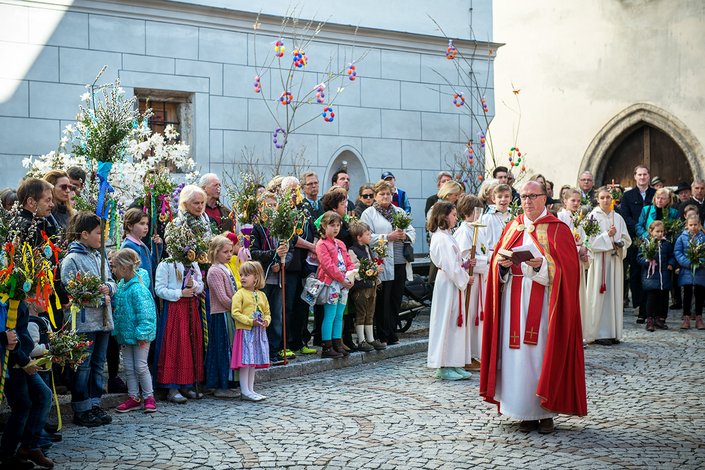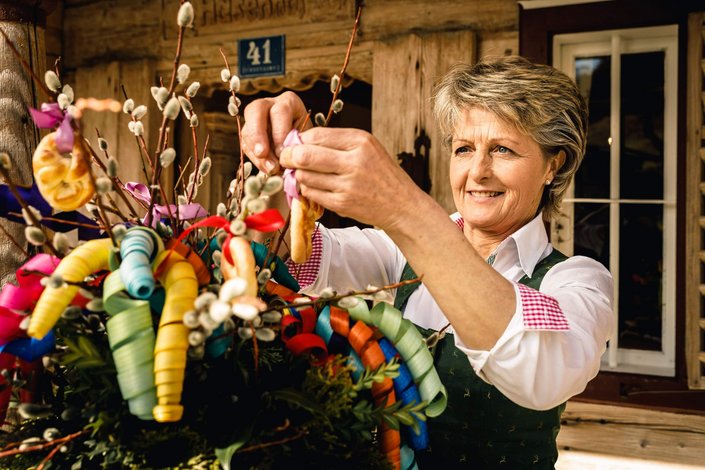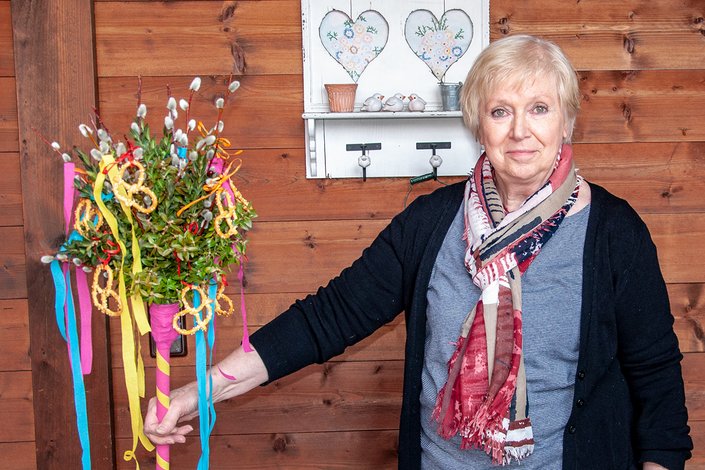More than just Easter decoration
Easter goes hand in hand with many widely known traditions. For example, there is the rabbit that brings the colorful eggs, the festive Easter snack or the spinach dinner on Maundy Thursday. In Kitzbühel - as in many parts of Tyrol - there is already a week before Easter, on Palm Sunday, a first festive highlight with the Palm Procession. Especially children and young people attend the service with so-called palm bouquets or palm poles to have the green-colored bouquets consecrated. "In the past, and still today, the bunches were placed under the roof or in the corner of the Lord's house to ward off mischief throughout the year," says Maria Fäth, an expert on palm bunches and Easter customs. She herself learned how to tie the bouquets from her mother and patiently passes on her knowledge to preserve the tradition.
Bouquets for girls - bars for boys
"Traditionally, the boys carry the palm poles, which can even reach under the church roof, and the girls carry the palm bouquets, or bouquets. But nowadays this is no longer seen so strictly," says Maria Fäth and tells of tiny little bouquets that are even made for cars. So there is no exact rule for making palm bouquets, but there are a few essential ingredients that make a bouquet a palm bouquet: a sturdy stick made of wood, branches of boxwood, a few palm catkins (willow catkins), florist's wire, adhesive strips and colorful crepe paper. "Of course, you can also tie in olive branches, thuja or other evergreen branches. The important thing is the green color and a few palm catkins - as a sign of hope and the dawn of something new," adds the trained nurse. Accordingly, there are no palm leaves or even whole palm trees among the components, but why are palm bunches and not, say, "box bushes" tied? "The name comes, of course, from Palm Sunday, which goes back to Jesus' entry into Jerusalem, where people greeted him joyfully with palm branches. Because this entry was so festive, it is also the beginning of Holy Week," Maria Fäth explains, "besides, palm trees don't grow in Austria."
Make palm bouquets yourself
The first step in palm bush tying is the basic structure, the stick. It is wrapped with colored crepe paper as desired. Matching the length of the stick, the evergreen box and a few palm catkin branches are then attached to the upper end with florist's wire. They form the bouquet and are decorated in the next step. "As a sign of joy and departure, you pretty up the branches with colorful ribbons - some take colored braids, others cut crepe paper, you can do it according to taste," says Maria Fäth. Whether blue, pink, orange or red - what the individual colors stand for, moves completely into the background. As a traditional Easter color, however, yellow should not be missing.
A sweet highlight at the end
Last but not least, the palm bouquet is spruced up with a few nibbles, which most children already look forward to while they're making it. "The sweet pretzels are often already eaten down by the little ones in church," laughs the Tyrolean, "but there's nothing wrong with that, it's completely appropriate for children." By the way, the pretzels that round off the palm bouquets do not serve exclusively as intermediate fortification. They are the sign for the Greek letter Alpha and thus the new beginning that goes hand in hand with Easter. And at the latest when the consecrated bushes are distributed in the house after the palm procession for protection against disaster and disease, the pretzels should also be eaten.
![[Translate to EN:] Ostern in Kitzbühel](https://www.kitzbuehel.com/fileadmin/_processed_/c/2/csm_Ostern_in_Kitzb%C3%BChel_2019___Kitzb%C3%BChel_Tourismus__4__3d4a5939bd.jpg)


